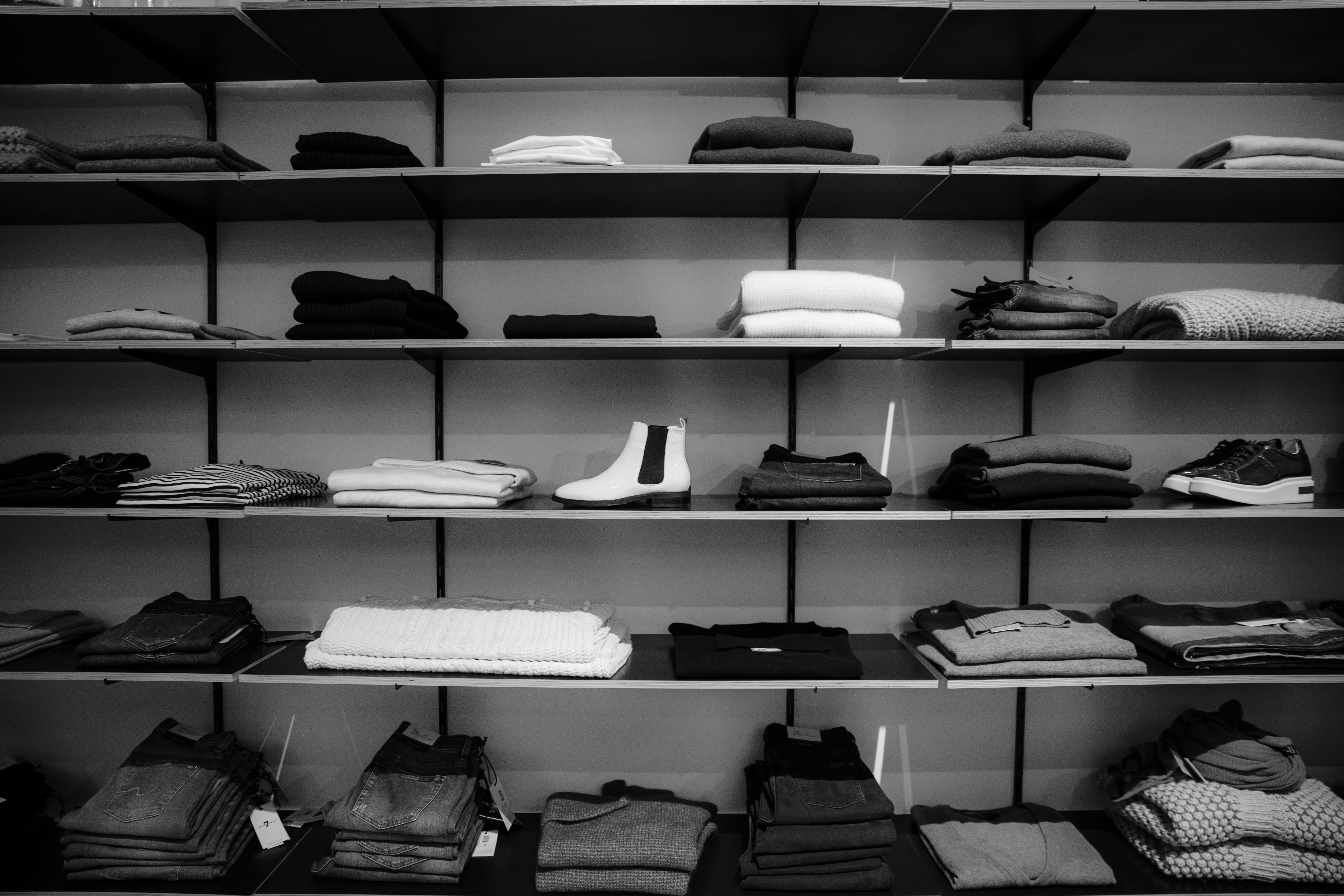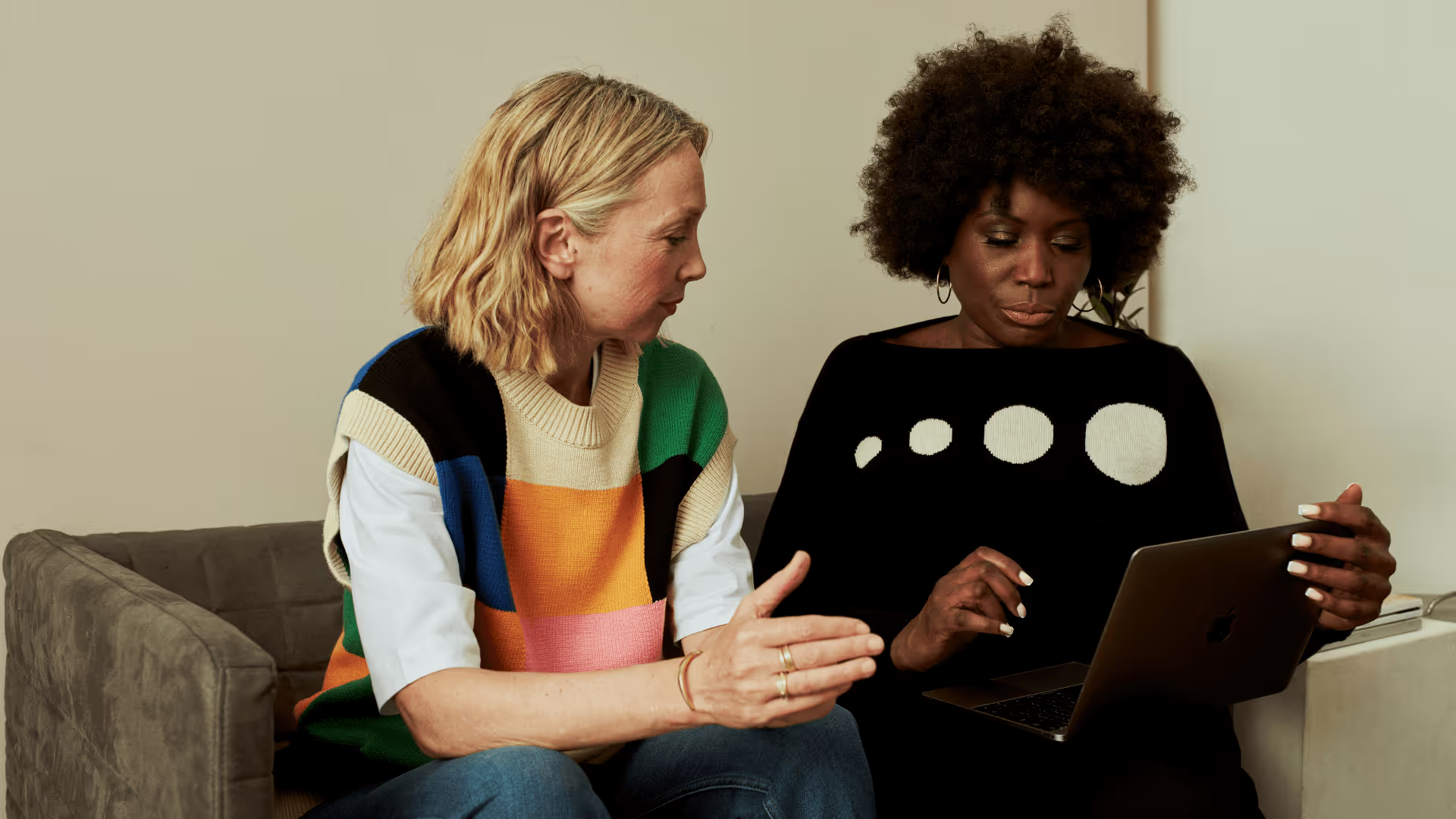Proven Wholesale Marketing Strategies to Grow Your Fashion Brand
Discover essential wholesale marketing strategies to elevate your fashion brand. This blog covers creating compelling presentations, utilizing platforms like JOOR, and adapting to new markets. Enhance your marketing strategy for wholesale business success.
%20(6)%20(1).avif)
Brief Summary
Wholesale marketing isn't just about being visible—it’s about building relationships, telling your brand story, and using data to create powerful buying experiences. This guide outlines how to market more strategically to retailers and strengthen your wholesale channel.
- Understand Your Ideal Buyer: Delve into market research and customer analysis to identify and profile wholesale buyers effectively.
- Engage Strategically: Customize outreach efforts, participate in industry events, and offer exclusive opportunities to build and maintain strong buyer relationships.
- Balance Digital and Personal Connections: Leverage digital platforms while valuing personal interactions to navigate the evolving wholesale landscape successfully.
Effective Wholesale Fashion Marketing Strategies for Brand Growth
.avif)
Behind every iconic wholesale fashion brand lies a robust wholesale marketing strategy. While runway shows and Instagram campaigns capture public attention, it's often the less glamorous world of wholesale fashion that propels brands from obscurity to ubiquity.
But navigating the wholesale landscape requires more than just great product lines. It demands a nuanced understanding of buyer needs, market trends, and the delicate balance between brand identity and retailer requirements.
As digital transformation reshapes traditional buying processes, you need to adapt your wholesale marketing strategy to stay competitive and grow.
Key Challenges and Opportunities in the Wholesale Fashion Market

The wholesale fashion market is a complex ecosystem with its own set of challenges and opportunities. To develop an effective wholesale marketing strategy, it's crucial to understand the current landscape.
Market Saturation and the Need for Differentiation
The global apparel market is expected to reach $2.25 trillion by 2025, with thousands of brands vying for attention. In the US alone, there are over 1,800 women's and girls' apparel manufacturing businesses. This saturation means buyers are inundated with options, making differentiation critical.
Shifting Buyer Behaviors and the Evolving Buying Cycle
The traditional buying cycle is evolving. According to a McKinsey report, consumers are still purchasing frequently but are buying less than historically recorded. This shift in purchasing patterns necessitates a more agile and responsive approach to wholesale strategies, emphasizing the need for brands to adapt quickly to changing consumer preferences.
Economic Volatility and Its Impact on the Fashion Industry
The fashion industry continues to face economic challenges. According to McKinsey's The State of Fashion 2024 report, 69% of fashion executives expect industry conditions to worsen or remain the same in 2024, with economic uncertainty cited as the top challenge. This ongoing volatility underscores the need for brands to maintain flexible strategies and robust contingency plans.
Sustainability and Ethical Sourcing as Buyer Priorities
As consumer interest in sustainability grows, buyers are increasingly seeking out brands with strong eco and ethical credentials. Many EU and US retailers even require proof of compliance, e.g GRS, Fair Trade, or OEKO-TEX® certifications.
Brands that can document their sustainability story in detail, be that with supplier audits, a certification or a record of their carbon footprint, gain a competitive edge.
Digital Transformation and AI-Driven Forecasting
AI tools are helping brands with forecasting demand, optimizing assortments, and avoiding overproduction. If you can provide a retailer with predictive analytics such as sell-through rates and inventory turnover, you’ll help to build an additional layer of trust into your wholesale marketing. Platforms like JOOR and Centric offer AI-driven insights that can help you gather this kind of data.
Creating a Strong Value Proposition in Wholesale Fashion
To stand out in the competitive wholesale fashion market, it’s essential to develop a clear value proposition. Focus on innovation by addressing unmet consumer needs with unique designs or enhanced functionality.
Offer strategic pricing that reflects both market trends and your brand's value, ensuring transparency to build trust with buyers. Creating exclusivity through limited editions or region-specific collections can generate buzz and increase demand. Emphasize quality and durability, showcasing your brand's craftsmanship with robust quality control and warranties.
A compelling brand narrative, whether through your founding story or commitment to social causes, helps form a deeper connection with consumers. Lastly, invest in efficient supply chain systems that ensure timely deliveries and reliable communication, maintaining strong relationships with buyers.
Understanding Wholesale Buyer Decision-Making
It’s important to remember that wholesale buyers are balancing multiple factors in their decisions. Your wholesale marketing strategy should address these key decision-making criteria while also offering attractive margins and demonstrating reliability in fulfillment and communication. To effectively implement these elements:
- Conduct regular market research to stay ahead of trends and consumer demands.
- Invest in product development that aligns with your chosen value propositions.
- Develop clear communication materials that articulate your brand's unique offerings.
- Build a robust digital presence that allows buyers to easily access information and place orders.
- Implement systems for tracking sell-through data and sharing these insights with buyers.
- Continuously gather feedback from buyers and end consumers to refine your offerings.
Showcasing Brand Story and Lifestyle Appeal
Go beyond sharing your product specs and let buyers know exactly why your brand connects with end-consumers. How do your products fit into their lives and what do they add to it? Showcase your appeal using lifestyle imagery, your brand origin story and any cultural or mission-driven elements of your business that make it special.
Using Sales Data and Social Proof to Build Trust
To create a strong value proposition share metrics including reorder rates, bestsellers, and the amount of units sold per season to back up the claims you make.
Providing testimonials or case studies from existing stockists can also build buyer trust and prove that you are a competent business partner. You may also want to showcase any collaborations with influencers or media features of note, as third-party validation.
Optimizing Your Wholesale Presentation Strategy for Maximum Impact

Effective product presentation is crucial in wholesale fashion. How you showcase your brand and products can significantly influence whether you capture a buyer's interest or get overlooked. A strong presentation strategy blends visual appeal with practical information, helping buyers envision your products in their stores and making your brand stand out.
Create Visually Compelling Product Catalogs and Line Sheets
Your product catalog is often the first impression a buyer has of your brand, so make it count. Organize your products logically and ensure a clean, easy-to-navigate structure.
Use high-quality visuals, including lifestyle shots that show the products in context, and ensure consistency in branding through color schemes, fonts, and design. Line sheets should include essential details like SKUs, prices, and delivery dates, and if possible, consider creating digital catalogs with clickable elements for added interactivity.
Leverage Virtual Showrooms and Shoppable Lookbooks
Virtual showrooms and shoppable lookbooks have transformed the wholesale buying experience, offering interactive and dynamic ways to showcase collections.
These tools allow buyers to view products from multiple angles, zoom in on details, and explore garments in motion. Virtual showrooms provide 24/7 accessibility, reducing costs associated with physical showrooms while collecting valuable data on buyer interactions. This enhances buyer engagement and streamlines the purchasing process.
JOOR's solution, for example, provides tools for comprehensive product presentation. Our virtual showroom offers 360-degree product visualization and high-resolution zoom functionality, allowing buyers to examine items in detail.
You can create custom collections and curate assortments for specific buyer segments, facilitating targeted presentations. These features enable you to showcase your products thoroughly and tailor your offerings to different market needs.
Highlight Bestsellers with Buyer Analytics
Use past sales reports to guide buyers toward your high-performing SKUs. Adding labels to these pieces with phrases like ‘proven bestsellers’ or ‘fast movers’ will make them stand out on linesheets and help catch buyers' eyes when they are looking through catalogs.
Incorporate Sustainability and Mission in Presentations
If possible, dedicate a page in your lookbook to your sustainability efforts. Include mentions of any environmentally-friendly material you use, highlight if your packaging is biodegradable and explain how consumers can recycle your products. Add callouts or icons to eco-products within your linesheet, so they are immediately visible to buyers.
Connecting with the Right Buyers in Wholesale Fashion
Success in wholesale fashion hinges on connecting with the right buyers for your brand. This process goes beyond simply identifying potential retailers; it requires a nuanced understanding of your target audience's needs, preferences, and behaviors.
By developing a clear picture of your ideal buyer, you can tailor your product offerings, marketing strategies, and communication approaches to resonate more effectively.
Reaching the right buyer audience involves a multi-faceted approach that combines data analysis, market research, and ongoing engagement with your existing customer base. This strategic focus allows you to allocate your resources more efficiently, targeting the buyers most likely to form lasting partnerships with your brand.
How to Identify Your Ideal Wholesale Buyer for Better Marketing
Knowing your ideal buyer profile is key to successful wholesale marketing. Here’s how to refine your strategy:
- Market Research – Study industry reports, attend trade shows, and analyze competitors.
- Customer Analysis – Identify patterns among your most successful retail partners.
- Profiling – Define key traits of wholesale buyers (store size, location, demographic) and end consumers (lifestyle, preferences).
- Feedback Loops – Regularly gather insights from buyers to adapt to their evolving needs.
- Data-Driven Targeting – Leverage industry databases and wholesale platforms to find the right buyers.
Refining your buyer profile ensures stronger partnerships and higher sales.
Reach the Right Wholesale Buyers for Your Brand
Identifying buyers is just the first step—success comes from strategic, personalized engagement that highlights your brand’s value.
Tailor your outreach
- Customize your pitch based on each buyer's specific needs and preferences
- Highlight how your brand can fill gaps in their current offerings
- Demonstrate understanding of their target market
Participate in industry events
- Attend relevant trade shows and fashion weeks
- Participate in industry webinars or virtual events
Offer exclusive opportunities
- Provide early access to new collections for key buyers
- Create limited edition pieces for specific retailers
Building and maintaining relationships with wholesale buyers is a continuous effort that extends far beyond the initial sale. It requires consistent, valuable communication and a deep understanding of each buyer's evolving needs.
Use Social Media and Influencer Prospecting
- Post on Instagram and TikTok to help boutique owners discover your brand
- Use LinkedIn to connect with decision-makers at retailers you want to do business with
- Track trending hashtags and use relevant ones to help attract wholesale attention
Build Loyalty with Buyer Retention Programs
- Offer discounts to drive repeat orders
- Create exclusive products for key retail partners
- Give previous buyers early access to retain their business
Balancing Digital & Personal Connections in Wholesale Marketing

While digital platforms have shaken up many aspects of wholesale marketing, the value of personal connections cannot be overstated. Today's successful brands must navigate a landscape that demands both online engagement and face-to-face interaction.
This dual approach allows you to leverage the efficiency and reach of digital tools while still benefiting from the trust and rapport built through in-person encounters. By strategically combining online and offline strategies, you can create a comprehensive approach to buyer relationships that maximizes visibility, encourages loyalty, and drives sales.
Trade Show Strategies to Build Strong Buyer Relationships
To maximize trade show success, start by researching attendees and scheduling meetings in advance. Craft a compelling brand story and design an inviting booth that fosters authentic, personal connections.
During the event, leverage technology like tablets and mobile apps to showcase personalized lookbooks and capture buyer interests in real-time. After the show, follow up with personalized messages referencing key conversations and invite buyers to exclusive virtual events or previews to keep the connection strong beyond the trade show floor.
Maximizing Connections at Virtual Trade Shows
Strategic planning can make virtual trade shows just as impactful as in-person events. Designing a virtual booth with private meeting options and scheduled video consultations helps create a personalized experience. Platforms like JOOR Passport allow for tailored booth experiences based on buyer data.
Live Q&A sessions, small-group product demonstrations, and real-time chat features ensure meaningful engagement.
After the event, leveraging collected data for personalized follow-ups and offering exclusive one-on-one virtual showroom tours helps strengthen relationships and maintain buyer interest.
Hybrid Selling: Combining Digital and Physical Touchpoints
Use Zoom and virtual showrooms to introduce buyers to new collections and then follow up with sample boxes so they can have a tactile experience with the product.
This hybrid fashion marketing strategy helps to cut costs but still allows buyers to see your collection in person, and keeps a personal element with the physical touchpoint.
Leverage Wholesale Management Platforms
Wholesale management platforms have become indispensable tools for brands looking to streamline operations, enhance buyer relationships, and drive growth.
These platforms offer a centralized solution for managing every aspect of the wholesale process, from product presentation to order fulfillment. By utilizing the right platform, you can significantly improve your efficiency, visibility, and ability to make data-driven decisions.
Optimizing Wholesale Operations with Management Platforms
Wholesale management platforms streamline operations by automating order management, inventory, and invoicing, while providing 24/7 global access to collections. Their data-driven insights help analyze sales trends and buyer behavior, improving strategy and growth.
When choosing a platform, prioritize user-friendly interfaces, virtual showrooms, and real-time inventory tracking to enhance efficiency and expand market reach.
Enhancing Buyer Experience with Seamless Ordering
A smooth ordering process boosts buyer satisfaction and sales. Wholesale platforms simplify this with intuitive navigation, real-time inventory updates, and flexible ordering options and clear wholesale pricing. Automated order processing, seamless inventory integration, and real-time shipment tracking further streamline operations, ensuring a hassle-free experience for buyers.
Elevate Your Customer Service
Exceptional customer service is a crucial differentiator in wholesale fashion. Wholesale platforms enhance this by enabling proactive communication about new collections and restocks, offering personalized recommendations based on buyer history, and providing multiple support channels for quick issue resolution.
Resources like digital lookbooks and styling guides support sell-through, while feedback loops help you continually refine your offerings based on buyer input.
By leveraging a comprehensive wholesale management platform like JOOR, you can create a centralized hub for all buyer interactions and data. This not only enhances operational efficiency but also provides the tools and insights needed to build stronger, more productive relationships with your wholesale buyers.
Automating Reorders and Predicting Seasonal Trends
Wholesale management platforms can suggest reorder timings for buyers based on inventory depletion rates, prompting you to reach out to your connections and see if they need any assistance. These B2B platforms can also predict seasonal spikes so you can make sure you have enough stock to meet demand ahead of time.
Expand into New Markets

As your fashion brand grows, expanding into new international markets can offer exciting opportunities for increased revenue and brand recognition. However, global expansion is a complex endeavor that requires careful planning, cultural sensitivity, and strategic adaptation.
Success in new markets depends on your ability to understand and cater to local preferences while maintaining your brand's core identity.
Conducting Market Research for Global Expansion
Thorough market research is the foundation of successful global expansion. It requires a deep dive into the local fashion landscape of each target market. This involves studying street styles in major cities, analyzing the product offerings of both local and international competitors, and understanding consumer behavior patterns.
Effective research goes beyond surface-level trends, uncovering cultural preferences, seasonal demands, and buying habits unique to each region. These insights allow you to develop a tailored pricing strategy that accounts for local economic conditions, such as average income levels, consumer spending habits, and applicable import duties and taxes.
Striking the right balance between affordability and profitability is essential to positioning your brand appropriately within the local market.
Adapting Products and Marketing for New Markets
Successfully entering new markets often requires product adaptation and localized marketing strategies. This may include adjusting sizing to fit local body types, modifying fabric choices to suit different climates, or even developing special collections that incorporate regional design elements or color preferences.
Demonstrating respect for the local culture while maintaining your brand’s identity can enhance your appeal to new customers. Additionally, your marketing messages must resonate with local values and aspirations.
Adapting your brand story for international audiences is essential. Highlighting aspects that resonate with local culture builds credibility and loyalty. Choosing the right distribution channels—whether department stores, online platforms, or local boutiques—ensures alignment with consumer habits.
Compliance with regional regulations concerning labeling, safety standards, and advertising claims is also critical to avoid costly legal issues. Continuously refining your strategies based on market feedback and evolving conditions is vital for sustained growth and successful brand development.
Localizing Catalogs, Pricing, and Communication
To make international business easier, translate linesheets and lookbooks into local languages when possible and offer your prices in local currency. Adjust sizing charts for local body types and examine if you need to implement region-specific pricing to keep up with your competitive set.
Create Your Brand's Comprehensive Wholesale Marketing Strategy

Mastering wholesale marketing in fashion is a multifaceted endeavor that requires strategic thinking, adaptability, and a deep understanding of both your buyer needs and market trends.
From crafting compelling brand presentations and using technology to creating personal connections and expanding into new markets, success hinges on your ability to differentiate your brand in a saturated landscape.
From utilizing virtual showrooms and tailoring your outreach to leveraging wholesale management platforms and adapting to international markets - you can position your fashion brand for growth and long-term success in the competitive wholesale space.
FAQs
How do I find the right wholesale buyers for my brand?
Use JOOR Discover to prospect from thousands of verified fashion retailers and make long-lasting business relationships. Search the retailer directory using a variety of filters to find the right retailer for your brand.
What makes a strong wholesale catalog or linesheet?
An effective linesheet or catalog should include all your product information, multiple images, clear wholesale pricing and ordering information and a brief overview of your brand and the mission behind your products.
How important is sustainability to buyers in 2025?
According to a 2025 GMI report, the global sustainable clothing market is expected to grow from 3.9 billion in 2025 to 9.4 billion in 2034. As sustainability becomes increasingly important for consumers, it in turn becomes increasingly important for buyers.
How is wholesale different from retail or DTC sales?
Wholesale sales come from other businesses, while DTC sales or retail come directly from your customers either via your website or your own physical store.
What margins do wholesale buyers usually expect?
When selling wholesale, buyers expect your profit margin to be anywhere between 15% and 50%.
Related Insights

Why Digital B2B Catalogs are Essential for E-Commerce Businesses
Online catalogs have become a crucial component for retailers and their buyers in an evermore tech reliant industry. Read about how these dynamic product libraries act as comprehensive selling solutions that plug into current buying behaviors.
%2520(2)%2520(1).avif)
8 Ways a B2B Fashion Marketplace Solves Wholesale Scaling Challenges
Learn how a B2B fashion marketplace like JOOR helps your wholesale fashion brand overcome scaling challenges. Maximize resources, build retailer relationships, and enhance distribution to drive growth in the global wholesale fashion market.
%2520(1).avif)
Price Sheets Vs Line Sheets in Wholesale Fashion
Explore the key differences between price sheets and line sheets in wholesale fashion. Optimize product showcasing and sales strategies with clear pricing details and captivating visuals. Enhance buyer experience and streamline ordering process effectively.
.avif)
Connected Wholesale Fashion Management: The JOOR Advantage
Dive into the world of connected wholesale fashion with JOOR, the game-changer in the industry. From flexible order management to insightful data analytics, explore the three key ways JOOR propels connected wholesale growth.
%2520(2)%2520(1).avif)
8 Ways a B2B Fashion Marketplace Solves Wholesale Scaling Challenges
Learn how a B2B fashion marketplace like JOOR helps your wholesale fashion brand overcome scaling challenges. Maximize resources, build retailer relationships, and enhance distribution to drive growth in the global wholesale fashion market.

3 Key Insights to Power Your Wholesale Business
Industry-wide sales data from analysts and trade groups can certainly paint the big picture. But don’t you wish you could dig a little deeper, and understand the real ‘what’ and ‘how’ behind the bird’s eye view?


